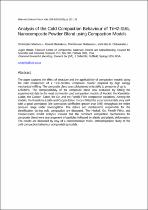 ResearchSpace
ResearchSpace
Analysis of the cold compaction behaviour of TiH2-316L nanocomposite powder blend using compaction models
JavaScript is disabled for your browser. Some features of this site may not work without it.
- ResearchSpace
- →
- Research Publications/Outputs
- →
- Conference Publications
- →
- View Item
| dc.contributor.author |
Machio, Christopher N

|
|
| dc.contributor.author |
Machaka, Ronald

|
|
| dc.contributor.author |
Shabalala, T

|
|
| dc.contributor.author |
Chikwanda, HK

|
|
| dc.date.accessioned | 2015-09-09T13:33:43Z | |
| dc.date.available | 2015-09-09T13:33:43Z | |
| dc.date.issued | 2015-07 | |
| dc.identifier.citation | Machio, C.N., Machaka, R., Shabalala, T. and Chikwanda, H.K. 2015. Analysis of the cold compaction behaviour of TiH2-316L nanocomposite powder blend using compaction models. In: Seventh International Light Metals Technology Conference(LMT 2015), Port Elizabeth, South Africa, July 27-29 | en_US |
| dc.identifier.uri | http://www.scientific.net/MSF.828-829.121 | |
| dc.identifier.uri | http://hdl.handle.net/10204/8131 | |
| dc.description | Seventh International Light Metals Technology Conference(LMT 2015), Port Elizabeth, South Africa, July 27-29. Due to copyright restrictions, the attached PDF file only contains the abstract of the full text item. For access to the full text item, please consult the publisher's website | en_US |
| dc.description.abstract | The paper captures the effect of structure and the applicability of compaction models using the cold compaction of a TiH2-SS316L composite powder prepared by high energy mechanical milling. The composite blend was cold pressed uniaxially to pressures of up to 1250MPa. The compressibility of the composite blend was evaluated by fitting the experimental data to the most commonly used compaction models of Heckel, the Kawakita-Lüdde, the Cooper- Eaton, the Ge, and the Panelli-Filho compaction equations. Among the models, the Kawakita-Lüdde and Cooper-Eaton models fitted the experimental data very well with a good correlation (the correlation coefficient greater than 0.99) throughout the entire pressure range under investigation. The nature and mechanisms responsible for the densification during cold compaction are discussed. The Heckel, Ge, Panelli-Filho, and Cooper-Eaton model analysis showed that the dominant compaction mechanisms for composite blend were rearrangement of particles followed by elastic and plastic deformation. The results are discussed by way of a comprehensive model intercomparison study of the cold compaction behaviour using existing models. | en_US |
| dc.language.iso | en | en_US |
| dc.publisher | Trans Tech Publications | en_US |
| dc.relation.ispartofseries | Workflow;15409 | |
| dc.subject | Titanium powder | en_US |
| dc.subject | Composite powder | en_US |
| dc.subject | Axial cold compaction | en_US |
| dc.subject | Densification behaviour | en_US |
| dc.title | Analysis of the cold compaction behaviour of TiH2-316L nanocomposite powder blend using compaction models | en_US |
| dc.type | Conference Presentation | en_US |
| dc.identifier.apacitation | Machio, C. N., Machaka, R., Shabalala, T., & Chikwanda, H. (2015). Analysis of the cold compaction behaviour of TiH2-316L nanocomposite powder blend using compaction models. Trans Tech Publications. http://hdl.handle.net/10204/8131 | en_ZA |
| dc.identifier.chicagocitation | Machio, Christopher N, Ronald Machaka, T Shabalala, and HK Chikwanda. "Analysis of the cold compaction behaviour of TiH2-316L nanocomposite powder blend using compaction models." (2015): http://hdl.handle.net/10204/8131 | en_ZA |
| dc.identifier.vancouvercitation | Machio CN, Machaka R, Shabalala T, Chikwanda H, Analysis of the cold compaction behaviour of TiH2-316L nanocomposite powder blend using compaction models; Trans Tech Publications; 2015. http://hdl.handle.net/10204/8131 . | en_ZA |
| dc.identifier.ris | TY - Conference Presentation AU - Machio, Christopher N AU - Machaka, Ronald AU - Shabalala, T AU - Chikwanda, HK AB - The paper captures the effect of structure and the applicability of compaction models using the cold compaction of a TiH2-SS316L composite powder prepared by high energy mechanical milling. The composite blend was cold pressed uniaxially to pressures of up to 1250MPa. The compressibility of the composite blend was evaluated by fitting the experimental data to the most commonly used compaction models of Heckel, the Kawakita-Lüdde, the Cooper- Eaton, the Ge, and the Panelli-Filho compaction equations. Among the models, the Kawakita-Lüdde and Cooper-Eaton models fitted the experimental data very well with a good correlation (the correlation coefficient greater than 0.99) throughout the entire pressure range under investigation. The nature and mechanisms responsible for the densification during cold compaction are discussed. The Heckel, Ge, Panelli-Filho, and Cooper-Eaton model analysis showed that the dominant compaction mechanisms for composite blend were rearrangement of particles followed by elastic and plastic deformation. The results are discussed by way of a comprehensive model intercomparison study of the cold compaction behaviour using existing models. DA - 2015-07 DB - ResearchSpace DP - CSIR KW - Titanium powder KW - Composite powder KW - Axial cold compaction KW - Densification behaviour LK - https://researchspace.csir.co.za PY - 2015 T1 - Analysis of the cold compaction behaviour of TiH2-316L nanocomposite powder blend using compaction models TI - Analysis of the cold compaction behaviour of TiH2-316L nanocomposite powder blend using compaction models UR - http://hdl.handle.net/10204/8131 ER - | en_ZA |





